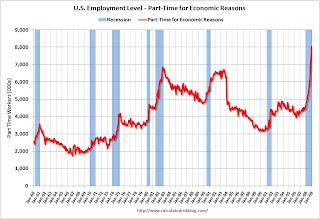by Calculated Risk on 2/01/2009 03:01:00 PM
Sunday, February 01, 2009
Unemployment Forecast
Here is a preview of the January employment report (due Friday) from Rex Nutting at MarketWatch: Fifth straight month of heavy layoffs should push jobless rate to 7.5%
The axe fell on an expected half million jobs last month, economists say, and the only reason the job losses weren't larger is that weak hiring for temporary jobs in November and December meant fewer people were laid off in January.Over a year ago, I put together a forecast showing the effects of the recession would linger for some time, but that the headline unemployment rate (U-3) wouldn't exceed 8%. Still many more workers would be underemployed (as counted in U-6).
...
The unemployment rate is expected to rise to 7.5% in January from 7.2% in December. It would be the highest unemployment rate since 1992. Economists expect the jobless rate to hit nearly 9% by early next year.
The logic was related to the structure of the economy; historically layoffs in manufacturing drive the unemployment rate, and since a much smaller percentage of U.S. workers are now employed in manufacturing - and manufacturing never really recovered from the 2001 recession - I felt manufacturing layoffs like in the '50s or '70s would have less of an impact on overall employment. Also many more employees are moved to part time work these days (as opposed to lost jobs), and these employees aren't included in the headline unemployment rate (but are included in U-6).
For most of 2008 I tracked job losses in construction and retail, however the employment picture changed rapidly in September.
 Click on graph for larger image in new window.
Click on graph for larger image in new window.This graph shows the cumulative changes in employment starting in August 2007 (red line is total nonfarm employment). Total employment peaked in December 2007, but the graph starts earlier to show the three key areas - construction, retail and manufacturing - that all saw earlier job losses.
For some time the total job losses were far less than the combined losses in construction, retail and manufacturing, suggesting other areas of the economy were doing OK.
However starting in September 2008, job losses in other areas of the economy started increasing rapidly.
The employment diffusion index from the BLS tells the same story.
 A diffusion index is a measure of the dispersion of change. This gives a feel for how widespread job gains and losses are across industries. The closer to 50, the more narrow the changes in employment.
A diffusion index is a measure of the dispersion of change. This gives a feel for how widespread job gains and losses are across industries. The closer to 50, the more narrow the changes in employment.Until September, the employment diffusion index was above 40, suggesting the job losses were limited to a few industries. However since then, especially in November and December, the diffusion index plummeted, suggesting job losses are now widespread.
With widespread job losses, the unemployment rate could move much higher. I've seen a number of forecasts for double digit unemployment in 2010 (even 12% or more). The U.S. economy hasn't seen double digit unemployment since the early '80s.
 This graph shows the unemployment rate and the year over year change in employment vs. recessions.
This graph shows the unemployment rate and the year over year change in employment vs. recessions.The unemployment rate rose to 7.2 percent in December; the highest level since January 1993.
And year over year employment is now strongly negative (there were 2.6 million fewer Americans employed in Dec 2008 than in Dec 2007).
 And not only has the unemployment rate risen sharply, but the number of workers only able to find part time jobs (or have had their hours cut for economic reasons) is now over 8 million for the first time ever (although the U.S. population has increased significantly since the early '80s).
And not only has the unemployment rate risen sharply, but the number of workers only able to find part time jobs (or have had their hours cut for economic reasons) is now over 8 million for the first time ever (although the U.S. population has increased significantly since the early '80s).So, even with less of an impact on unemployment from manufacturing job losses (as compared to the '50s or '70s) and more workers finding part time work, the unemployment rate will probably still move higher than 8% - and could well move much higher.
It is difficult to gage the impact of the Obama stimulus package on employment. As an example, with commercial real estate construction coming to a screeching halt, many more construction workers will lose their jobs in 2009. However this might be somewhat offset by more public construction projects.
I think double digit unemployment is now very possible, although I'll take the under 10% (at least for now).
Best to all. Football fans: Enjoy the game!


